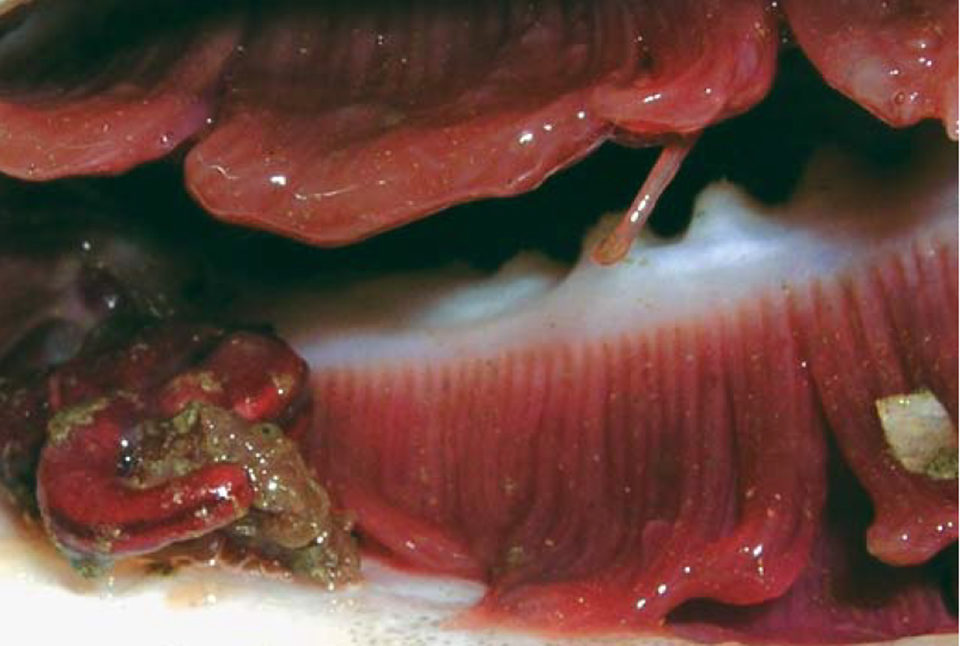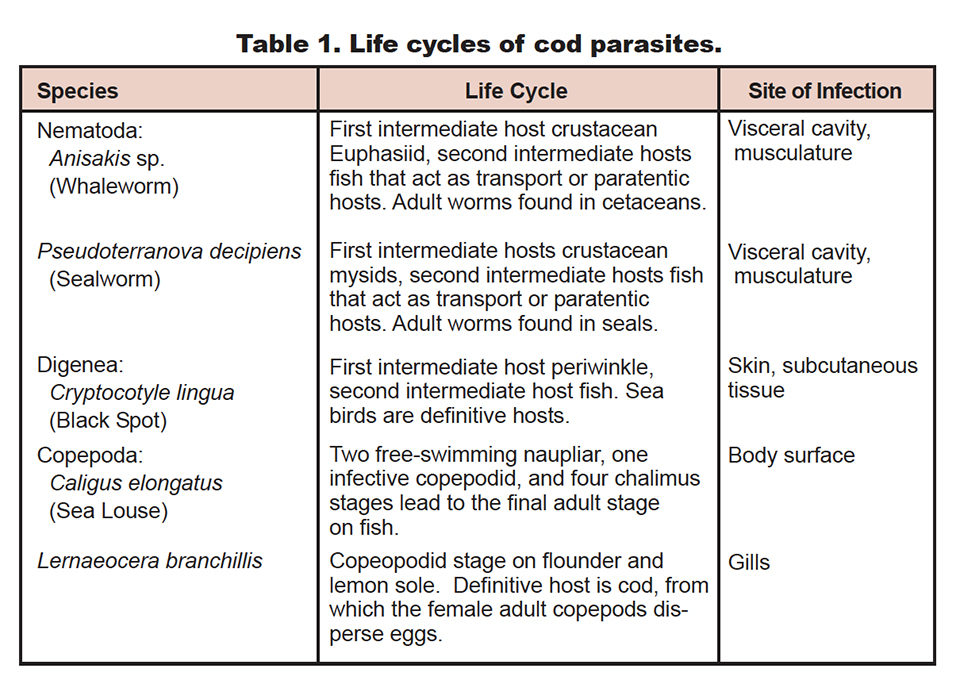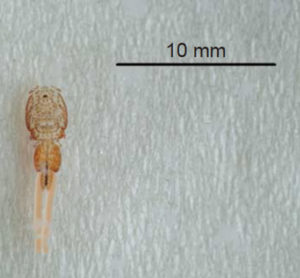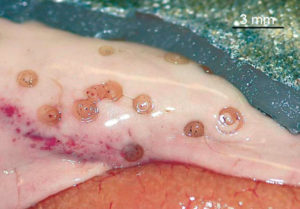Site-specific health management, biosecurity protocols essential

Atlantic cod (Gadus morhua), one of the leading food fish in the United Kingdom, have traditionally been fished in Scottish waters. Currently 270,000 metric tons (MT) of G. morhua are consumed every year in the U.K., but with decreasing wild stocks, this demand could in part be met through the cultivation of the species.
Wild Atlantic cod have an exceptionally varied parasite fauna, most of which causes little or no effect on the fecundity and health of the fish. The distribution of parasites within wild populations of cod are not random, but tend to be dispersed. The ecological processes that determine parasite distribution in wild cod are likely to result in different distribution and abundance of the parasites in farmed cod.
Densely farmed cod may be at greater risk if environmental conditions favor certain parasites and allow their populations to increase to a high level. However, farmed cod may have reduced loads of parasites if the cod can be isolated from intermediate hosts that carry infective stages of the parasites.
It is difficult to predict which parasites of the many naturally occurring species may arise as a problem to future cod aquaculture. Therefore, parasitologists at the FRS Marine Laboratory in Aberdeen, Scotland, are conducting baseline prevalence studies of parasites in wild cod and identifying those that may trouble cod cultivation in the future.
Transmission

Principal factors in the transmission of parasites between wild and farmed cod will be whether the parasites have direct monoxenous life cycles or indirect heteroxenous life cycles with many intermediate hosts, and the distribution of these hosts within the vicinity of fish farms.
Many cod parasites possess complex life cycles with stages that infect definitive hosts where maturation and sexual reproduction take place or involve asexual proliferation in intermediate hosts such as aquatic snails. Transmission between definitive and intermediate hosts can occur through free-living infective stages, as seen with sea lice, Caligus elongates; or predation by one host on the previous host in the life cycle, as with Anisakis sp. and Cryptocotyle lingue (black spot).

Pathology
Most individual fish in wild populations are infested with parasites, but in the majority of cases, no significant harm appears to ensue. Parasites directly affect the health of the stock and spoil the appearance of the product, therefore reducing its market value.
Lernaeocera branchialis

of I. R. Bricknell.
The parasitic copepod (Lernaeocera branchialis), a parasite of the gills of cod, is probably the most serious pathogen of wild cod. Parasitized fish show markedly decreased condition and reduced deposition of fat in the skeletal muscle. Once settled on the gills of cod, adult female L. branchialis push their heads deeply into the hosts’ tissues, damaging the heart and causing anemia.
Risks to farmed fish could occur with the placing of fish less than 1 year old at sites where the intermediate host (flat fish) is present in early summer/autumn, when the cod are particularly susceptible to infection.
Cryptocotyle lingua (black spot)
Cryptocotyle lingua, or black spot, is a common parasite of cod that visit rocky shores during the summer. Juvenile cultured cod could be killed if free-swimming infective cercaria released from the intermediate periwinkle host penetrate the brains or hearts of the cod. The marketing of fish can also be hindered if large numbers of parasite-induced black spots cover the skins or surfaces of fish fillets.
Caligus elongatus
Sea lice (Caligus elongates) are a copepod crustacean parasite of many marine species including Atlantic cod. Through their attachment and feeding, copepodid and chalimus stages cause variable levels of localized damage. When present in high numbers, the parasites can cause significant pathology that results in mortality.
Ascaridoid Nematodes
Anisakis species and Pseudoterranova decipiens, both principal species involved in human infection by the family Anisakidae, have the potential to infect the flesh of cod. The parasites show limited infection within fish, but humans can become incidental hosts if fish are eaten raw or undercooked.
Control

The challenges presented to control parasites in Atlantic cod cultivation are multifaceted and must take into account a large number of variables. Transmission of parasites can occur directly, via vectors, or through environmental media such as water.
The main threat to farmed cod from parasites comes from those with direct or a single-host life cycle, such as Caligus elongatus, transmission of which is favored by the dense concentration of fish in intensive farming situations. In contrast, parasites with an intermediate host such as Cryptocotyle lingua undergo asexual reproduction within the intermediate host, the periwinkle. This increase in biotic potential can make control efforts more difficult.
The development, implementation, and ongoing enforcement of site-specific health management and biosecurity protocols are essential for the long-term financial and operational sustainability of cod farming. Careful site selection and improved pest management can minimize potential impacts from these pathogens.
Integrated control is an overall approach using strategically employed tactics based on knowledge of the life cycle and ecology of the parasite. It avoids overdependence on a single method and recognizes that no single method is likely to be 100 percent effective.
(Editor’s Note: This article was originally published in the December 2005 print edition of the Global Aquaculture Advocate.)
Now that you've finished reading the article ...
… we hope you’ll consider supporting our mission to document the evolution of the global aquaculture industry and share our vast network of contributors’ expansive knowledge every week.
By becoming a Global Seafood Alliance member, you’re ensuring that all of the pre-competitive work we do through member benefits, resources and events can continue. Individual membership costs just $50 a year. GSA individual and corporate members receive complimentary access to a series of GOAL virtual events beginning in April. Join now.
Not a GSA member? Join us.
Authors
-
Rachel Kilburn
Fisheries Research Services
FRS Marine Laboratory
P.O. Box 101, 375 Victoria Road
Aberdeen AB11 9DB
Scotland[107,117,46,99,97,46,98,97,108,114,97,109,64,114,110,114,117,98,108,105,107]
-
Campbell Pert
Fisheries Research Services
FRS Marine Laboratory
P.O. Box 101, 375 Victoria Road
Aberdeen AB11 9DB
Scotland -
Dr. David Bruno
Fisheries Research Services
FRS Marine Laboratory
P.O. Box 101, 375 Victoria Road
Aberdeen AB11 9DB
Scotland -
Dr. Rob Raynard
Fisheries Research Services
FRS Marine Laboratory
P.O. Box 101, 375 Victoria Road
Aberdeen AB11 9DB
Scotland
Related Posts

Health & Welfare
New molecular techniques detect nodaviruses in Atlantic cod hatcheries
The nodaviruses that can infect the nervous systems of Atlantic cod threaten further expansion of the burgeoning cod-farming industry.

Health & Welfare
Small-scale, submersible fish cages suitable for developing economies
The low-cost, low-infrastructure nature of OCAT open-ocean cage systems allows fish farmers to move from protected bay and harbor sites to more exposed locations that offer better water quality.

Health & Welfare
Atlantic cod genomics and broodstock development project
The Atlantic Cod Genomics and Broodstock Development Project has expanded the gene-related resources for the species in Canada.

Health & Welfare
Killing methods, post-slaughter quality, part 3
Slaughter methods can impact product quality. It is recommended that fish be fasted prior to slaughter to clean their digestive tracts. Instant killing minimizes the degradation of tissue quality. Immediate bleeding is more important than the bleeding method.


